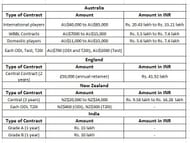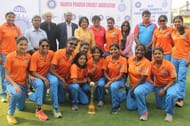
How do you look at India’s World Cup campaign? Has it ended with just a heart-breaking loss to England in the Final? Or has it potentially sparked a new beginning for Women’s Cricket in India?
Before this World Cup, most cricket fans would have struggled to name all the players in the Indian squad. After the World Cup, Mithali Raj and the Women in Blue have become new toast of the nation – the final result notwithstanding.
So what has changed within a month’s time?
The live telecast has no doubt helped in attracting more viewership. However, brilliant individual performances were mainly responsible for the respect and recognition from the fans.
On their way to the final, the Women in Blue punched above their weight by defeating higher ranked teams like England (in group stage), New Zealand and Australia.
It is now up to the BCCI to acknowledge this public recognition and interest and take immediate steps to improve Women’s Cricket in India. In order to do that, they will need to proactively evolve some of the primitive practices still prevalent in women’s cricket.
Low pay in comparison International Cricketers
The difference in the amounts paid to contracted top Indian International cricketers like Mithali Raj and her overseas counterparts like Meg Lanning or Heather Knight is bewildering.
Here is a comparison:

This clearly shows that, at best, Indian women earn on par with the New Zealand cricketers. The major difference here, though, is that the BCCI – the parent board of Indian Women’s Cricket in addition to the men's, is the richest cricket board of all.
Australia is the only country that has developed a full-fledged contract system for both international and domestic women cricketers.
For someone like Meg Lanning, playing in the World Cup (excluding knock-outs), an Ashes series (1 Test, 3 ODIs, 3 T20Is) and a full season of WBBL will fetch her close to AU$89,000 (Rs. 45.47 lakhs) in 2017.
Now, compare this to some senior Indian cricketers like Mithali Raj, Jhulan Goswami and Harmanpreet Kaur who have been awarded Grade A contracts. The difference is huge, even if you take into account Kaur’s WBBL contract.
In addition to this, the BCCI has made no announcement for women’s contracts for the 2016-17 season.
In March 2017, the Board revised men’s contracts and doubled the amount with top male cricketers getting Rs. 2 crores per annum. Did they forget about women’s contracts?
Top women cricketers in India are not even getting 10% of what Virat Kohli is earning. Will the Board try to bridge this huge disconnect when it decides to announce new contracts for women?
BCCI’s Lethargy towards Women’s Domestic Cricket

The BCCI’s neglect towards women’s domestic cricket is appalling. The other cricket boards like Australia and England have taken firm steps to improve their women’s domestic cricket.
Cricket Australia is the only board to cover their domestic cricketers under central contracts.
The WBBL further strengthens the financial condition of their domestic cricketers. It ensures that women’s cricket in Australia is looked upon as a feasible full-fledged career option for budding cricketers.
The England and Wales Cricket Board (ECB) does not have a contract for their domestic players. However, they have launched a Women’s Cricket Super League (WCSL) to try to address the gap between domestic and international cricket.
The ECB have pledged £3million to the league over four years with the funds being used for overall growth of women’s domestic cricket.
Women’s domestic cricket in India, on the other hand, seems to be still living in the primitive age. A senior domestic player at the first-class level expects to earn around Rs. 30,000.
That’s Rs. 2500 per month. Who gets paid Rs. 2500 per month these days? In addition, each day of play in the BCCI tournaments gets a woman cricketer Rs. 3500. If you are not in the playing XI, you get half of that.
There is a dearness allowance (DA), which varies from Rs. 500 to Rs. 1000 a day. The DA is only for the duration of the tournaments. Players attend all pre-season camps and/or training camps out of pocket.
A junior player eligible to play in the Under-19 and the Under-23 tournaments does relatively better, as do those who get picked for the two inter-zonal competitions.
A promising youngster, for instance, could make up to a lakh a year. A Ranji Trophy cricketer who does not have an IPL contract earns around Rs. 10-12 lakhs a year.
Railways is the only main organization that recruits most women cricketers. Air India also employs a few female cricketers.
Players employed by Railways get security of a government job, regular time off for playing and rewards for performing well.
However, it is not easy for all women to secure employment in Railways or Air India. That means for many senior cricketers and aspiring young ones, choosing either a corporate job or full-time cricket becomes a reality somewhere down the line - and one that often, they are forced to take.
We are living in an age where monetary deals of mind-boggling amount are a norm in Indian Cricket.
The BCCI is set to receive $405million from the ICC for the cycle 2016-2023. The IPL title sponsorship is sold for Rs. 2199 crores. The Indian Team’s sponsorship is bagged at Rs. 1079 crores.
The biggest buy in this year’s IPL player auction is for Rs. 14.5 crores. The IPL broadcast rights may very well be sold for an estimated $2billion.
Yes, all these numbers may be justifiable, but you cannot ignore the stark difference that exists in the financials of men’s and women’s cricket.
After the success of this year’s World Cup and the amount of interest it generated among the Indian audience, the BCCI must think more than just to spare a token amount for women’s cricket. The Board must seriously think of launching a Women’s IPL.
The BCCI rarely misses a good business opportunity that is of financial benefit. Now, it should not miss a golden opportunity to take women’s cricket in India to a much higher pedestal.
Looking for fast live cricket scores? Download CricRocket and get fast score updates, top-notch commentary in-depth match stats & much more! 🚀☄️
